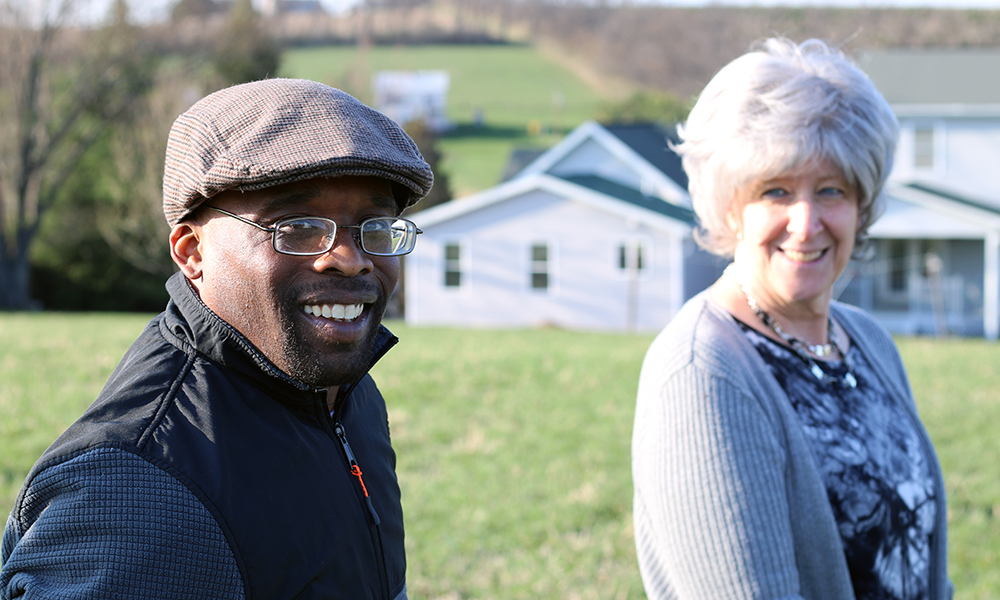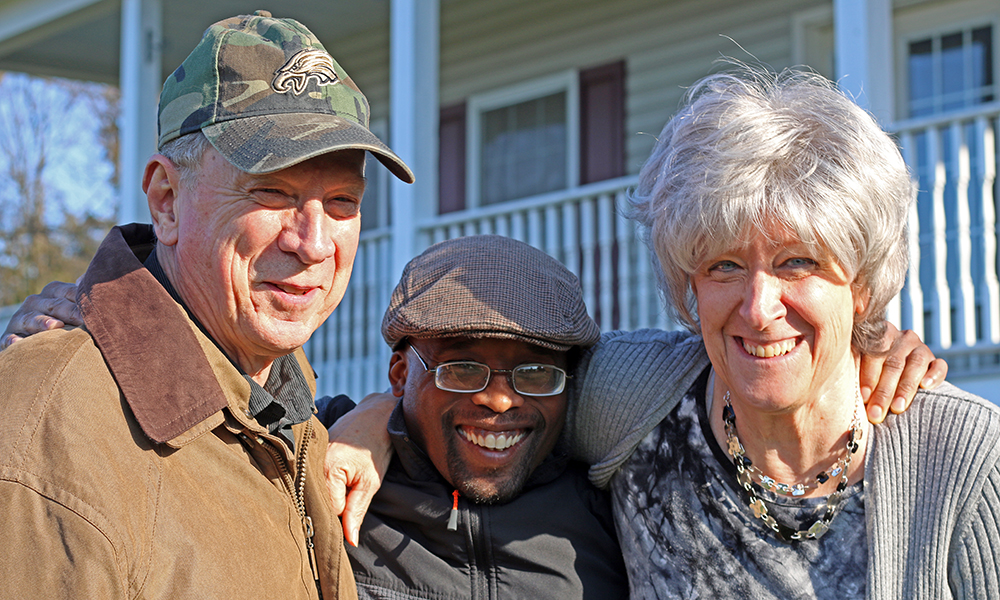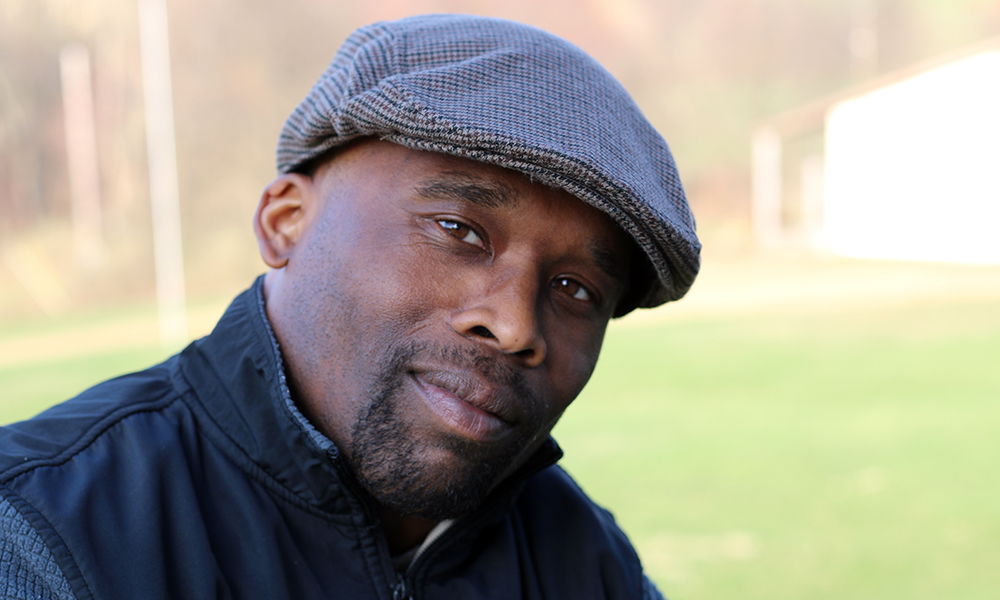
Photos and video by Micah Danney
Before Steven Cave met Cindy Sanford, he only “knew hate. I knew pandemonium.” The studio apartment the Sanfords added to their property, where Steve lives, will be made available for other released prisoners after he is able to strike out on his own.
Four months after he was released from prison, Steven Cave, 36, sat between the couple he calls his parents in Bloomsburg, Pa., and explained how their kindness showed him how to end a lifetime of chaos.
“I never was big on words,” he said.
That’s because Cave’s earliest memories are of his biological mother using words to mask a perverse pattern of abuse, sending him off with men and women she told him were uncles and aunts.
“I used to have people tie me up and just rape me brutally, to every type of degree,” Cave said.
There were dozens of them, he estimates. His mother, who was also sexually abused as a child, traded him regularly for money or drugs until he ran away at the age of 11. He lived homeless in North Philadelphia’s streets, sleeping in abandoned cars and finding food in dumpsters.
He soon fell in with the Crips. He was the gang’s youngest member, but his capacity for violence earned him the role of primary protector, he said. He was involved in drive-by shootings, violent stick-ups of drug dealers and store robberies.
Cave was sent to a facility for juveniles at 13. He was released at 16 and free for only six months before he was arrested in connection with a robbery and charged with gun possession. He was sentenced to five to 10 years.
“I became so vicious in prison because I feared ever being raped again,” Cave said. “My hate, it consumed me. My hate for just humanity. When I’d see a man, I’d see a man physically entering me, raping me. Taking something precious from me.”
His imprisonment at the start of his teens was the beginning of a 23-year odyssey of incarceration as a notoriously violent inmate that ended with a radical transformation. His life became so dark, it took only a small glimmer of light to guide him to a new consciousness.
Purposeful violence, vengeance
Of those 23 years, Cave spent 11 in solitary confinement. What was designed as corrective punishment instead fed into his destructive mindset and behavior, he said. Returning to the general population was not an incentive for change; he liked being where inmates threw milk cartons filled with urine on guards. Nor was getting out of prison any incentive. He didn’t want to leave.
[Related: Only Some Correctional Staff Being Taught How to Handle Traumatized Inmates]
His original sentence increased as he racked up new charges for assaults on other inmates and guards.
“As long as I got my stuff off, I didn’t care about the consequences,” Cave said. “I needed to see some type of pain or see blood to know somebody was in pain like I was.”
His motivations were retribution and release by violence. One attack on another inmate turned into an attack on a guard who tried to intervene. Sent to the hole, as solitary is known, Cave was frequently denied meals at the whim of a supervising lieutenant. He eventually rigged his cell door to not shut properly, then choked the lieutenant unconscious and stomped on his head until he thought the man was dead. Cave was 17.
He had many more serious altercations with inmates and guards. He was hospitalized several times after being beaten by groups of guards as retribution for assaults on their colleagues. In one incident, he stabbed an officer with a homemade shiv. Cave was charged with attempted murder.
“I didn’t have an in-between,” he said. “I didn’t have, ‘OK, I’m just gonna spit on you.’ No. Once I made up my mind, no, I was going to try to kill you, by any means necessary.”
One day in 2014, a guard told Cave he had a visitor. He had never been called for a visit before, so he thought it was a mistake or a ruse by the guards. Instead, it was Cindy Sanford, a retired nurse and volunteer with the Pennsylvania Prison Society. The group advocates for humane treatment of prisoners and trains volunteers to mentor people who are incarcerated or recently released.

Cindy Sanford and her husband Keith, a retired game warden, are politically conservative. Until a few years ago, they understood crime as a wrong choice people made that deserved punishment.
A disturbing bigger picture
Sanford had started volunteering after a small painting ended up in a gift shop she used to run. She discovered it was created in prison by a man convicted as a juvenile for his role in a double murder. She struck up a correspondence, which grew into a relationship that she wrote about in her book “Letters to a Lifer: The Boy ‘Never to Be Released,’” published in 2015.
Like much of their community, in bucolic farm country two hours’ drive from Philadelphia, Cindy and her husband Keith, a retired game warden, are politically conservative. Neither had any personal experience with the criminal justice system.
“I got a ticket once in the Air Force for speeding a couple miles over the speed limit coming off the base one time,” Keith said.
They understood crime as a wrong choice people made that deserved punishment.
“I was one of those types that would have said — you know, on blogs people write — ‘You can’t tell me they don’t know right from wrong at 15,’” Cindy said. “That would be as in-depth as I would go.”
Visiting men in prison and hearing about their childhood traumas changed that. It typically takes a few months to build enough trust, Cindy said, but when inmates share their stories, a disturbing bigger picture is revealed.
“I realized that I am who I am because of my environment, because of the love I was shown,” Cindy said. “I realized those things are not just nice things. They’re necessary for healthy human development.”
Her first visit with Cave was brief, but she was struck by the fact that he had had no visitors in 20 years. Cave was leery of this stranger, but when she asked if she could visit him again he said yes. He told himself he should throw away the paper she gave him with her mailing address, but it was like his hand had a Charley horse and wouldn’t let go, he said.
“I saw something that I wasn’t used to,” Cave said. “I was conscious of that. Cautious of that, but I wanted that, and that’s how my journey started with her. I just wanted what I seen in her eyes.”
Cave had a bad stutter and had trouble articulating, Cindy said, but they kept at it. He noticed how she was polite to guards and how they responded respectfully to her. He saw power in that, a power existing simultaneously with kindness.
He had only known white people to be abusive toward him or exert authority over him — his biological father called white people devils — but here was a white woman being kind to him. To accept that kindness, Cave had to challenge his core belief systems.
Cindy would tell him about her life, and Cave would express awe that her family would eat dinner together every night or go to the movies together. He started to tell her about his childhood. When she first hugged him, it was the first hug he had ever felt. He felt like he was in his mother’s arms, he said.
Other inmates noticed Cave smiling for the first time and commented on it. He started softening to everyone around him, and then apologizing to people he had mistreated. First inmates, then guards.
“I knew hate,” he said. “I knew pandemonium. I invested many years in that, so it was time to invest in just being happy, trying something new.”

On Dec. 26, 2017, after 23 years of incarceration in 14 of the state’s 22 prisons, Steven Cave walked out a free man.
Resist your homies
When they first met, Cave had told Cindy he didn’t want to leave prison because he had nothing on the outside waiting for him. Now he was starting to worry that the court system might keep him separated from the love he had found. But after four years of exploring his new mindset and behaviors, he was granted parole.
Cindy had to contact the parole supervisor to prevent Cave from being paroled back to his old neighborhood. She and Keith had a studio apartment built on the side of their house, and on the day after Christmas, after 23 years of incarceration in 14 of the state’s 22 prisons, Cave walked out a free man.
He’s taking things slowly. He was so overwhelmed when he first tried to fill a prescription that he walked away from the pharmacist midconversation. In prison, he was taught to avoid conflict by leaving interactions that were frustrating him. He’s learning to stay put and talk through situations. Cindy and Keith want him to have a firmer interpersonal foundation before he looks for a job, they said.
The couple’s friends and family have all been accepting and supportive of Cave. He goes to church with the Sanfords every week. “You should see him in my Sunday school class,” Cindy said. “The kids are all over him.”
One week, giving a lesson about making good decisions, Cave explained to the kids that when your homies want you to rob a bank with them, you need to resist that pressure.
“It was definitely not the material that was in the instruction manual,” Keith said, chuckling.
Cave takes medication that has helped reduce the nightmares that have plagued him since childhood. He started therapy a few months ago, and while he’s skeptical that it will do any good, he said he’s open to sticking with it. His apartment is spotless; the act of cleaning is like a spiritual ritual for him, he said. He wants to be a janitor and someday own his own cleaning company.
The Sanfords continue to build relationships with other prisoners in nearby facilities. They contact state legislators and wardens to advocate for more access to programs and mental health services. Responses are mixed, Cindy said. She was once suspended from visiting an inmate who was heard referring to her as “mom” and who kept a photo of her and Keith in his cell. Prison officials are wary of volunteers “getting too close” to inmates, as are superiors at the Prison Society.
The Sanfords see that as indicative of an inherently flawed mentality that has created a fundamentally broken system. Cindy understands the fear, she said, but called the current system an extension of the abuse so many inmates suffered as children. “Why don’t you look at this and realize that the very things you are trying to prevent are the things that can heal these people?” she said.
For Keith, who has long identified with the law enforcement community and its familial culture, the loyalty he sees from inmates who have gravitated to his and Cindy’s kindness is worthy of a deeper faith than the system affords people in its custody. He sometimes asks inmates he knows to look out for younger prisoners. “And they look you in the eye and say, ‘When I tell you I got him, I mean it. I got your back,’” Keith said.
Cave sees it as his mission to help the society he returned to understand the people it is willing to throw away. “Every abandoned child is craving the same thing,” he said, “and that is to be loved.”
Pingback: A Returning Prisoner's Story: 'Hate Consumed Me' | The Key Points
Pingback: Marshall Geisser Law | A Returning Prisoner’s Story: ‘Hate Consumed Me’
Pingback: A Returning Prisoner’s Story: ‘Hate Consumed Me’ | The Crime ReportThe Crime Report
You are an inspiration, Cave, for so many people – keep being the man God created you to be. I am sure the Sanfords enjoy your company as well- you should be proud of who you have become! I am awestruck by you, Cindy, and your husband Keith’s spirit and mission. I briefly met Cindy through a mutual friend at her book signing in her small town library for Letters to a Lifer, The Boy Never to be Released, that I also read, which is a testament to their great work. By chance, my sister- in- law bought us one of the prints the other inmate (Ken) she helped without knowing the connection, and is proudly displayedin or living room. You are all great people!
Know these people and Cave they go too my chruch and have touched our life by their explain.The Sandfords have been sent by God to help others to learn you change your future,no matter what you have been through. God Bless them and the people they touch.